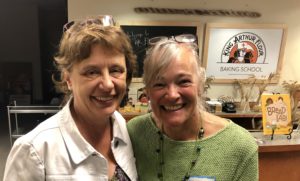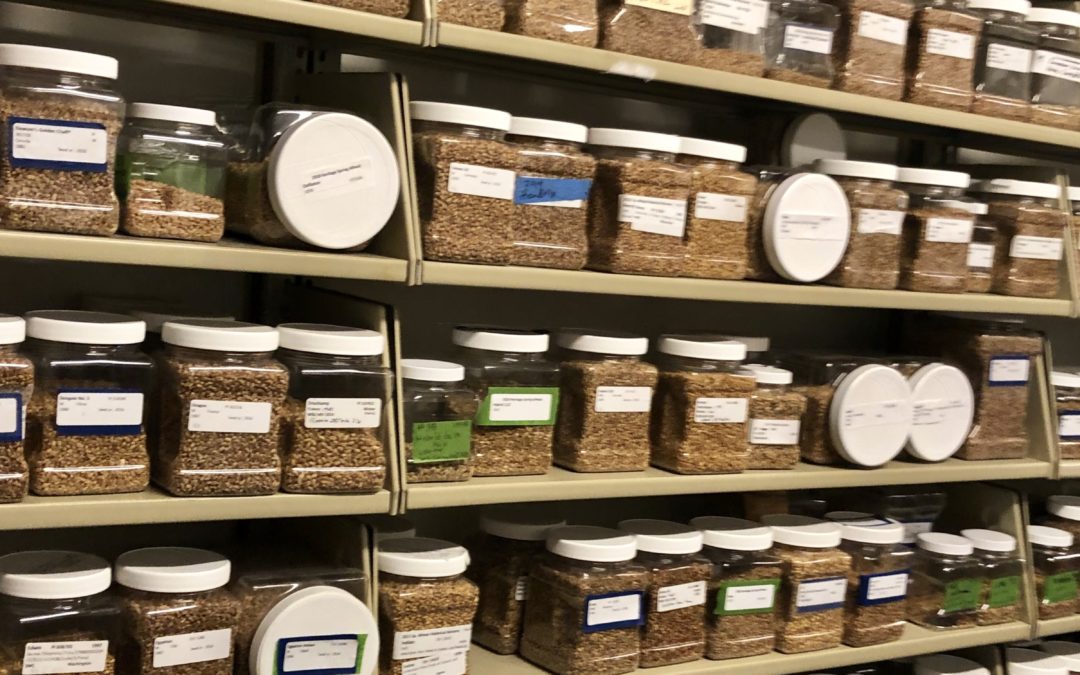
Kathryn Gardow and Ellen Gray at The Bread Lab and King Arthur Flour Baking School
June 3rd, the expiration date on the Pepperidge Farm white, rectangular, pre-sliced, loaf of bread on the top shelf at the Washington State University’s (“WSU”) Bread Lab near Mt. Vernon, Washington. It’s my birthday dinner, two days before the bread’s expiration date. I am savoring a 4-course meal with 80 other attendees supporting the Mt. Vernon High School’s (no- cuts) Girls Tennis Team. What do the Bread Lab and girls tennis have in common with each other? My long-time friend Ellen Gray, former Executive Director extraordinaire for a non-profit that advocated for sustainable food and farming in Washington, organized a dinner at The Bread Lab while raising funds for a sport she loves and the girls’ team she coaches. It all makes sense! An amazing woman brings two of her loves together to support both! Girls tennis and a delicious meal at The Bread Lab and hence, supporting sustainable food and farming.
Dr. Steve Jones, Director of the WSU Bread Lab and Professor in the Crop and Soil Sciences Department, is WSU’s fifth wheat breeder in 125 years of breeding this ubiquitous crop. Steve, a no-nonsense type of guy, says it like it is. He introduced our Bread Lab tour asking the 50 or so guests, “How often do you eat food that is non- food?”
Granted most of us in the room are conscious of where our food comes from, what our food is and try to eat real food. Too often we could be considered “foodies” or “food snobs” or “food elitists”! Yes, those words are often said with a sneer or a sense of a “know it all ism.” I just want to know where my food comes from and how it gets to my table. If that makes me a foodie, so be it.
Making Good Food Choices
What do I think about when I make my food decisions? Where is it grown? Is it grown in the United States, Mexico, Canada, China or elsewhere in the world? You may ask, “Why is it important?” The simple answer is every country does not have the same standards for quantity and quality of artificial, chemical-based pesticide, herbicide, and fertilizer use. With industrial, big agricultural operations, chemical inputs to feed the good plants and kill weeds and bugs are usually used. Some of the chemicals have been outlawed in the U.S. but are still used elsewhere in the world. There are just too many unanswered and un-researched questions on the impacts of chemical pesticides, herbicides, and fertilizers on the human body for my comfort.
Monsanto’s RoundUp, a widely and commonly used herbicide, has been banned, its use restricted or considered for restriction in more than 20 countries around the world. (Monsanto has been purchased by Bayer.) Glyphosate, the key ingredient in RoundUp, has been linked to cancer. Remember how long it took to really know that cigarette smoking caused cancer? It took more than 30 years for the known effects of smoking to affect change. In the end television, radio, and print advertisements were restricted, no smoking campaigns were led, warning statements were placed on cigarette packaging and eventually the number of smokers decreased. Just as with cigarettes, the links between RoundUp and cancer are real. I’m not willing to wait 30 years for the science and public policy to catch up to what is already known.
Once I know where my food is grown, I want to know how my food is grown? Is it certified organic? Is it a non-GMO (genetically modified organism)? Is it grown hydroponically? Once it is picked or slaughtered, how is it processed? Is it processed with lots of salt, sugar or corn syrup, or artificial flavors and colors?

Local Roots CSA pickup site
If possible, food grown by a farmer I know is my first preference. Shopping at the farmers’ market makes that easy. Often the farmer is the salesperson! Another option is every Tuesday during the growing season, Local Roots my weekly Community Supported Agriculture (“CSA”) farmer, delivers a box of freshly-picked produce to my neighborhood pickup spot. A five-minute walk to the farmer’s Mom’s house to retrieve my box of fresh greens, radishes, kale, carrots, and kohlrabi or other assortment of fresh veggies depending on what the farmer’s picked that week. Local Roots makes it easy to eat organically without a side of pesticides and herbicides.
What if I didn’t have a local farmers’ market or CSA, what other ways can you eat better and more safely? The best reference to know which foods are the cleanest and which are the most pesticide laden is the Environmental Working Group’s (“EWG”) Dirty Dozen and Clean 15. EWG’s Dirty Dozen are the 12 fruits and vegetables with the highest levels of pesticide residue found in its testing. Strawberries have been at the top of the Dirty Dozen list ever since I started paying attention. Spinach and kale are now in the number two and three position with the most pesticide residue. (I guess it means people are eating more kale!) Since purchasing organically is not feasible for many because of cost constraints or availability, the EWG’s Clean 15 is a reliable information source for those fruits and vegetables with the least pesticide residue. The cleanest are avocados, sweet corn, and pineapple, all produce you peel or strip off the outside skin. Check out the Dirty Dozen and Clean 15 lists to get the best information on what foods are the dirtiest and cleanest with respect to artificial chemical residue.

The Bread Lab Seed Library
The Bread Lab is doing phenomenal work with farmers, processors, academics, chefs, non-profits, business start-ups, and bread eaters to bring back lost wheat varieties and strains. Western Washington was once a bread basket of the west before wheat became commoditized and optimized for industrial scale agriculture and grown more in eastern Washington. The resurgence in profitable and great tasting wheat products in lower Skagit River valley about one hour north of Seattle is heartwarming and exhilarating. In The Bread Lab library, there are so many jars filled with a multitude of wheat seed varieties. Wheat, until recently, has been a low value crop in the Skagit rotated between higher value crops to rejuvenate and revitalize the soil so it become more friable and nutrient laden. Now these specialty wheat varieties are showing up as milled flours at Cairnspring Mills, in breads at the Breadfarm in Edison, in beer at Pike Brewing Company at Pike Place Market, in pastries and treats at Damsel and Hopper in Seattle’s Wallingford neighborhood, and at distilleries found on the Seattle Trail Map of the Washington Distillers Guild. Skagit wheats are showing up in so many places and taste great! I had a great Manhattan made with Copperworks whiskey made on Alaskan Way in Seattle!
Back to the White Bread
Steve asked us to look closer at the Pepperidge Farm loaf. It’s still squishy. That’s the sign of a refined wheat loaf more commonly known as white bread. It means it’s not whole wheat or multi-grain. The loaf hadn’t dried out and hardened, which typically happens when artisan bread isn’t used quickly enough. That is when chefs make croutons! And the loaf was still totally white, meaning it hasn’t molded and turned green or purple or blue. It’s good that a loaf of bread has two more days of shelf life and is still saleable and edible. However, upon closer look, the expiration date was actually June 3, 2018. The bread’s shelf life expired 363 days before my birthday. Wow! And it’s still soft and still white! Now that is cause for concern! What is in it that still makes it appear edible? I don’t think I want to know.
I’ll stick with eating genuine, bona fide, real food! Thanks to Ellen and Steve and the rest of the team for creating a meal at The Bread Lab that was memorable, tasted good and was real food, not non-food and celebrated my birthday, too!
Kathryn Gardow, P.E., is a local food advocate, land use expert and owner of Gardow Consulting, LLC, an organization dedicated to providing multidisciplinary solutions to building sustainable communities. Kathryn has expertise in project management, planning, farmland conservation, and civil engineering, with an emphasis on creating communities that include food production. Kathryn’s blog muses on ways to create a more sustainable world and good food!

